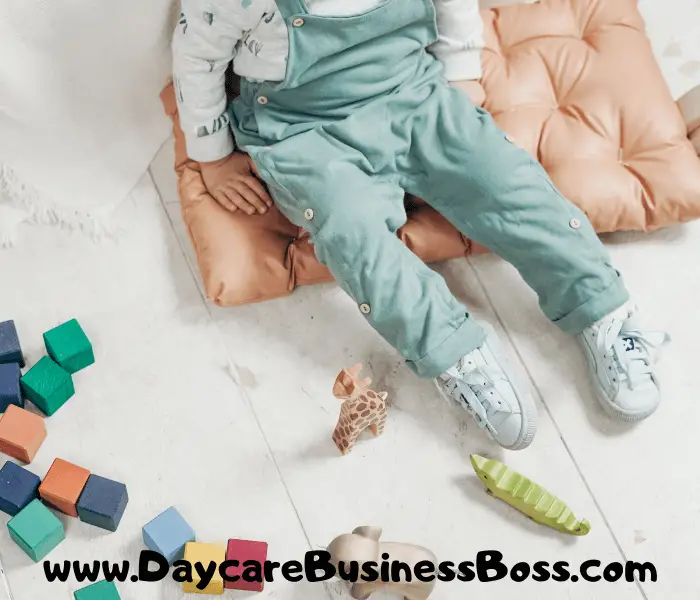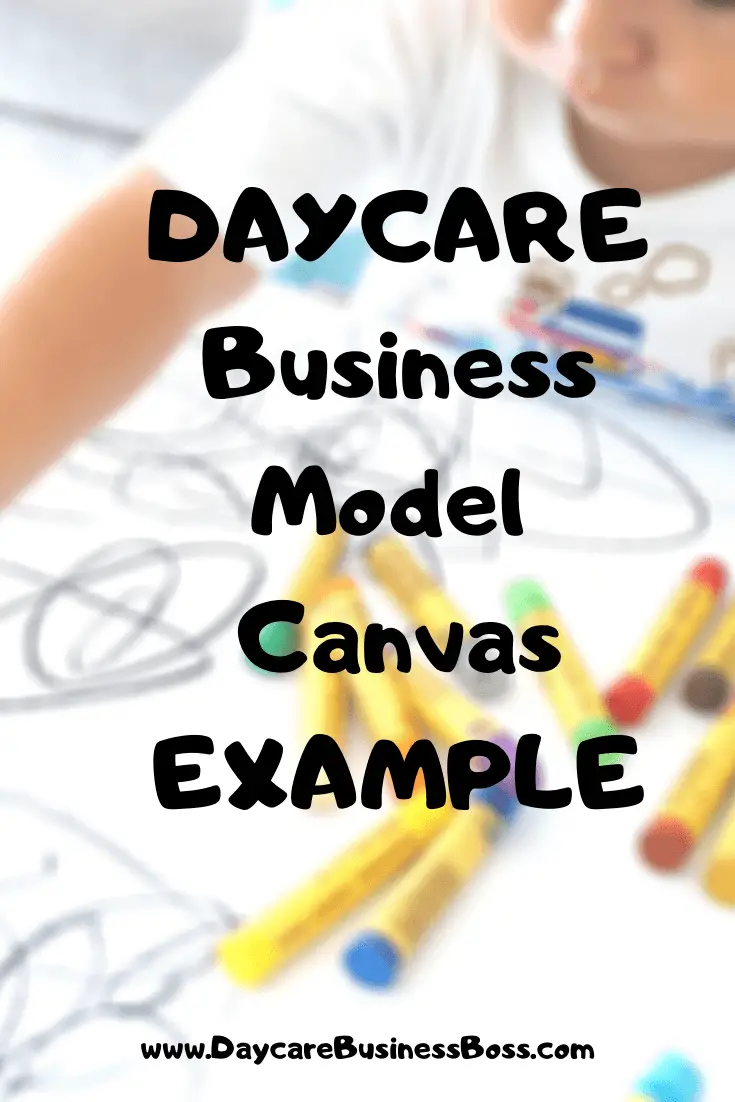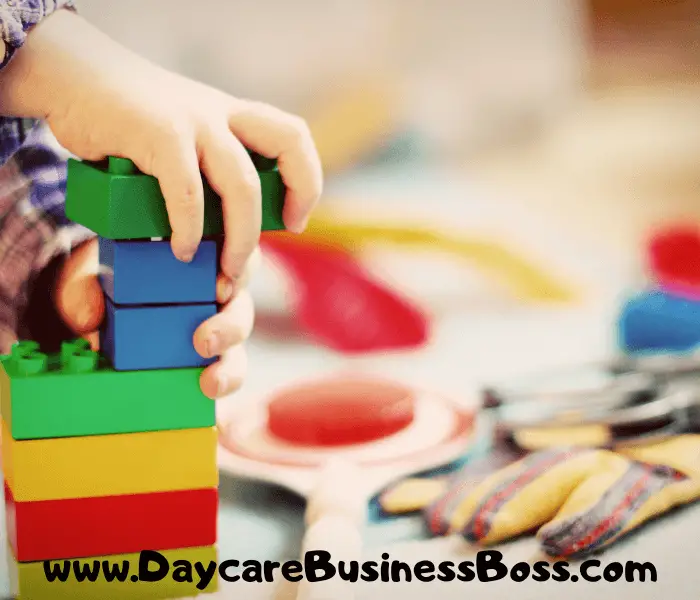Creating a business model canvas for your daycare is a great way to innovate and upgrade your current business plan. With a typical business plan, even if you are trying to be as concise as possible, it usually turns out wordy, long, and unappetizing for the reader.
Instead of paragraph after paragraph about information about your business, a business model canvas puts the most important items all on one page and broken down into 9 categories.
To create your business model canvas for your daycare, you need to complete these 9 sections:
- Customer segments
- Customer relationships
- Channels
- Value propositions
- Key activities
- Key resources
- Key partnerships
- Revenue streams
- Cost structure
We will go through each of these sections and give you examples of how you can take a typical paragraph from a business plan, then break it down into a couple of key points. At the end, we will have a full sample canvas with a template for you to fill out.
*For our examples and canvas at the end, we will be using “Safe & Sound Daycare” as an example. It is a privately-owned facility that focusses on affordable rates and a safe environment for the children.

1. Customer segments
The first section in the canvas covers the breakdown of your potential customers into well-defined customer segments. The reason for segmenting your customer base is to allow you to target the right customers who need your services.
If you’re trying to reach too broad of an audience, you will be spending too much money on marketing, and your message won’t be heard because there are certain customers who simply don’t need your services.
You can break down customer segments by:
- Age
- Income
- Marital status
- Geographic location
- Special needs/wants from their childcare
Example:
Safe & Sound Daycare has 2 main customer segments.
Our first is married couples who both work and have a combined income between $75,000 and $150,000 per year. We target this group first because they are in need of affordable childcare once the mother is off of maternity leave and needs to go back to work.
Our second is single parents who have an income between $45,000 to $100,000 per year. Similar to the previous group, these individuals are needing childcare so they can keep their job since they are a single income family.
We don’t market as much to low-income parents because we put an emphasis on safety and care at our facility. In order to keep our standards high, we need to charge a rate that is slightly above the lowest rates in the area. These families are willing to pay a little extra for our quality facilities, but still need an affordable rate.
Key Points:
- Middle-income families where both parents need to work
- Single parents who need to work during the day
- Parents who are looking for safety and affordability
- Not marketing to very low or very high-income families
2. Customer relationships
Your relationships with your customers will determine how many customers you retain, as well as how many new customers they will help bring in. Every daycare tries for great customer relationships, but there are so many other things to do at your daycare center, that sometimes these relationships take a hit.
The keys to having great customer relationships are:
- Be friendly, kind, and respectful to EVERY customer
- Every time you or an employee are talking to a customer, make sure you are treating them as best as you can. If you are having a bad day, and you let your frustration seep into your customer interaction, your business is going to take a hit.
- Keep your interactions friendly and brief
- You want to let your customers feel welcome and heard, but at the same time, you aren’t trying to keep them from going about their day or getting their child home.
- Identify your BEST customers
- Hopefully, you have a lot of good customers, but there will be a select few amazing customers who you should seek out. These are customers who are thrilled with your services and would be more than willing to spread the word about how great your facility is.
- Develop a referral program
- Having a strong referral program benefits your daycare in 2 ways. First, you get pre-qualified customers via your current customers. But you also build stronger relationships with your customers who did the referring. Once those customers have referred a friend to your facility, they have a bond with your daycare that will likely never be broken.
Example:
At Safe & Sound Daycare we aim to treat all of our customers with the respect and kindness they deserve. We are on our first-name basis with all of our customers and do our best to make them feel like their child has a home away from home at our facility.
We are very thankful for our truly loyal and enthusiastic customers. These customers are at the core of the success of our daycare facility. We help out these customers by offering them incentives for referring their friends and family to our facility.
Key Points
- Every customer is treated with respect and kindness
- Identify great customers and go above and beyond for them
- Leverage our great customers into referrals
3. Channels
Channels is referring to marketing channels, in other words, what platforms are you going to use to get the word out about your daycare facility. Some typical marketing channels are:
- Website
- Social media
- Search engine optimization
- Search engine advertising
- Newspapers
- Flyers
- Brochures
- Billboards
- Car advertising
Each business has different needs for their marketing, also, each target market in each community responds differently to different channels. This can make it tricky to find the perfect mix of marketing channels.
The best way to combat this issue is to test out a handful of channels, closely monitor your results, and then make adjustments as needed. This way you are not breaking the bank, but also get valuable feedback about your marketing efforts.
Example:
Most of our digital marketing goes through Facebook Groups and our website. We target local Facebook Groups that have parents actively involved in them. When we post in these groups we are directing people to our website, where they can learn more and book a daycare session.
Our print marketing is mainly flyers and brochures that we distribute weekly to select neighborhoods near our facility.
Key points
- Facebook Groups
- Website
- Locally distributed flyers and brochures
4.Value propositions
Your value proposition is the reason why customers should come to your facility instead of the competition. It is the thing, or things, that your business does better than everyone else.
Some typical value propositions:
- Lower cost
- Exceptional service
- High quality
- Excellent facilities
- Educational services
- Gifted & talented program
- Special needs assistance
- Bi-lingual education
- Convenient options
- Overnight or 24-hour care
Example:
At Safe & Sound Daycare we offer unmatched safety for your child, while also keeping our rates affordable. At our facility we believe you shouldn’t have to choose between affordability and safety, with our modern facility, highly-trained staff, and extensive safety measurements, you can have the peace of mind knowing your child is safe, while also not breaking the bank.
Key points
- Safety
- Affordability
- Peace of mind
5. Key activities
These are the things you are doing to follow through on your value proposition. How are you going to provide your exceptional service to the customer? These can be things like:
- Getting a loan to update facilities
- Charge a higher rate so you can offer better services
- Extensively train employees
- Keep class sizes small
- Marketing effectively to increase revenue
Example:
We have found a balance between medium-sized groups and having well-qualified staff to ensure every kid is safe and is receiving enough attention. With the medium-sized groups we can keep rates relatively low while also bringing in enough money to keep our service quality high.
- Medium class sizes
- Highly trained staff
- Affordable, but not rock bottom, rates
6. Key resources
Similar to key activities, your key resources also help you achieve your value proposition. But instead of things you are doing, they are things that help you do what you need to do.
Things like:
- Convenient location
- High-end CRM software
- Well-trained employees
- Quality facilities
- Using tech to teach
- Large outdoor play area
- Security
- Medical expertise
Example:
Along with high-quality facilities, all of our staff go through CPR, first-aid, and conflict management training before they start with us. Our owner, Lucy, is also a licensed EMT and served as one for 8 years before starting Safe & Sound Daycare.
Key points
- Highly-trained staff
- Quality, safe facilities
- Licensed EMT as the owner
7. Key partnerships
Hopefully, you have made some friends in your local business community. If you haven’t, it is time to reach out to see if there are any businesses in your area that you can form a mutually beneficial relationship with.
Typical partners for daycare centers could be:
- Universities
- Schools
- Corporations
- Hospitals
- Summer camps
- Children’s stores
- Recreation centers (Girls & Boys Club)
Example:
We have partnered with our local hospital who provides our staff with medical training and medical care for children at our facility. They have also kindly donated an extensive amount of medical supplies and safety equipment. In return, we offer their employees a discounted rate for child care at our facility.
- Partnering with a hospital adds credibility to the safety of our facility
- Taps into a large customer base at the hospital
8. Revenue streams
If you have a daycare facility, your main revenue stream is likely going to be daily child care, but, it is always best to diversify. If you can add a couple of other revenue streams to supplement your daily child care income, you will create a bit of a safety net and make your facility more resilient to difficult times.
Some options for other revenue streams:
- Blogging
- Online instructional videos
- Creating educational activities
- Offering summer camps
- Parenting or behavioral classes
- Selling products
- Hosting children’s parties or events
Example:
The bulk of our revenue, about 80%, is currently coming from child care. Right now we have about 10% coming in from summer camps and 10% from parenting classes. This summer we are hoping to offer 2 more camps to increase revenue. We are also trying to put together some online instructional videos from our parenting classes and sell those online.
Key points
- Classes and camps to supplement income
- Trying to increase revenue from those
- Exploring other revenue streams
9. Cost structure
Your cost structure is an overview of how you are going to be spending your money to make your daycare a success. This isn’t a full-blown financial report, but it will touch on the key components that readers should know. Things like:
- Renting vs. owning a facility
- Are you taking out a loan
- How much staff will be hired
- How much staff will be paid
- How much you will spend on facility maintenance or improvements
- How much you will spend on IT services
- How much you will spend on food
Example:
We have purchased our own facility and a small loan to help with initial improvements. After this, we plan on investing consistently to improve our facilities and keep them at a quality level.
We will have 4 child care providers employed and 4 support staff to assist. In total, we plan on budgeting $12,000/mo for child care providers and $8,000/mo for support staff.
Key points
- Quality facilities
- Plans to improve facilities
- Adequate amount of staff

Daycare Business Model Canvas Example
| Key Partners
Partnering with the local hospital.
They provide training and supplies, we provide discounted child care for employees. |
Key Activities
Medium class sizes
Highly-trained staff
Affordable rates |
Value Propositions
Safety
Affordability
Peace of mind |
Customer Relationships
Treat every customer with respect and kindness
Identify great customers
Leverage referrals |
Customer Segments
Middle-income families where both parents need to work
Single parents who need to work during the day
Parents who are looking for safety and affordability
Not marketing to very low or very high-income families |
| Key Resources
Highly-trained staff
Quality, safe facilities
Licensed EMT as the owner |
Channels
Facebook groups
Website
Locally distributed flyers and brochures |
|||
| Cost Structure
● Owning facility ● Loan to cover initial improvements ● 4 child care providers and 4 support staff |
Revenue Streams
● Child care (80%) ● Parenting classes ● Summer camp ● Online instructional videos (upcoming) |
|||
Please note: This blog post is for educational purposes only and does not constitute legal advice. Please consult a legal expert to address your specific needs.
Use this canvas model to start your Daycare today! Checkout our startup course and documents here.


Meet Shawn Chun: Entrepreneur and Childcare Business Fan.
I’m a happy individual who happens to be an entrepreneur. I have owned several types of businesses in my life from a coffee shop to an import and export business to an online review business plus a few more and now I create online daycare business resources for those interested in starting new ventures. It’s demanding work but I love it. I do it for those passionate about their business and their goals. That’s why when I meet a childcare business owner, I see myself. I know how hard the struggle is to retain clients, find good employees and keep the business growing all while trying to stay competitive.
That’s why I created Daycare Business Boss: I want to help childcare business owners like you build a thriving business that brings you endless joy and supports your ideal lifestyle.



